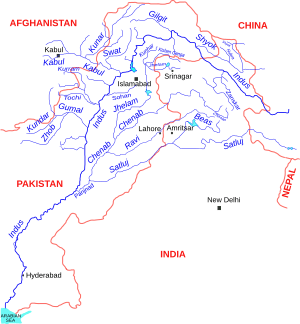Indus Waters Treaty facts for kids
The Indus Waters Treaty is a special agreement about sharing water. It was made between India and Pakistan. This important treaty was signed in Karachi on September 19, 1960. Jawaharlal Nehru, who was India's Prime Minister, and Mohammad Ayub Khan, Pakistan's President, signed it. The World Bank also helped and signed the treaty as a third party.
The Indus River System has six main rivers. These rivers flow through both India and Pakistan. The treaty divides these rivers into two groups.
Eastern and Western Rivers
The first group is the Eastern Rivers. These are the Sutlej, the Beas, and the Ravi. The treaty says that India gets to use all the water from these Eastern Rivers. This applies before the rivers flow into Pakistan.
The second group is the Western Rivers. These are the Indus, the Jhelum, and the Chenab. Pakistan gets to use all the water from these Western Rivers.
Pakistan also received some money. This was a one-time payment. It helped make up for the water from the Eastern Rivers.
Working Together on Water
The treaty also makes sure both countries work together. They agree to share information about the rivers. This helps them manage the water properly.
For this reason, the treaty created a group called the Permanent Indus Commission. Each country chooses a special person, called a commissioner. These commissioners work together to make sure the treaty is followed.


